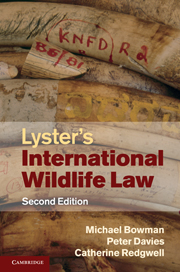Book contents
- Frontmatter
- Contents
- Foreword
- Preface
- List of abbreviations
- PART I Foundations of international wildlife law
- PART II Species regulation
- PART III Regional wildlife regulation
- PART IV Global wildlife regulation
- 13 The Ramsar Convention on Wetlands
- 14 The World Heritage Convention
- 15 The Convention on International Trade in Endangered Species of Wild Fauna and Flora
- 16 The Convention on the Conservation of Migratory Species
- PART V Biological diversity: a new perspective on wildlife regulation
- PART VI Cross-sectoral issues in wildlife regulation
- PART VII Conclusion
- Index
- References
16 - The Convention on the Conservation of Migratory Species
Published online by Cambridge University Press: 05 July 2011
- Frontmatter
- Contents
- Foreword
- Preface
- List of abbreviations
- PART I Foundations of international wildlife law
- PART II Species regulation
- PART III Regional wildlife regulation
- PART IV Global wildlife regulation
- 13 The Ramsar Convention on Wetlands
- 14 The World Heritage Convention
- 15 The Convention on International Trade in Endangered Species of Wild Fauna and Flora
- 16 The Convention on the Conservation of Migratory Species
- PART V Biological diversity: a new perspective on wildlife regulation
- PART VI Cross-sectoral issues in wildlife regulation
- PART VII Conclusion
- Index
- References
Summary
Background
Amongst the measures agreed at the 1972 Stockholm Conference was Recommendation 32 of the Action Plan, which urged governments to consider the need to adopt international conventions in order to protect species which inhabit international waters or migrate from one territory to another. This was prompted by the realisation that failure to protect a migratory species throughout every stage of its migration could severely damage efforts to maintain or restore its population. The endangered Siberian crane (Grus leucogeranus), for example, though relatively secure in its Russian breeding sites, has traditionally encountered various threats along its migration routes, including hunting in Pakistan and Afghanistan. Similarly, many species of North American breeding birds had suffered declines in population because of deforestation and the use of pesticides in their central and South American wintering habitats. Passerines breeding in Northern Europe have traditionally run a biannual gauntlet through the Mediterranean region, where they are shot and trapped in their thousands en route to and from their African wintering grounds. Although various existing treaties had accorded a degree of protection to migratory species, it was felt that these lacked uniformity or cohesion and covered only a proportion of the species that could benefit from international co-operation.
- Type
- Chapter
- Information
- Lyster's International Wildlife Law , pp. 535 - 584Publisher: Cambridge University PressPrint publication year: 2010



